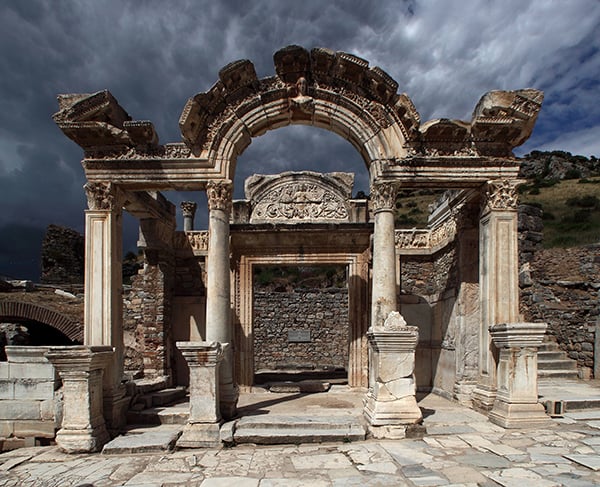
The Alamo, the ancient Turkish city of Ephesus, and Saudi Arabian rock art dating back 10,000 years are among the 24 newly-minted World Heritage Sites recognized by the United Nations Educational, Scientific and Cultural Organization (UNESCO).
The ancient carvings in the Hail Region of Saudi Arabian desert can be found in a two-part site at Jabel Umm Sinman at Jubbah and the Jabal al-Manjor and Raat at Shuwaymis. Desert travelers formerly stopped in the area to draw water from a no-longer extant fresh water lake.
The Alamo, along with four nearby San Antonio missions, becomes the first World Heritage Site in Texas, joining such important US landmarks as the Statue of Liberty and the Grand Canyon in sharing the designation.
The Alamo, the former Mission Valero church in San Antonio.
Photo: Robert Howen, © National Park Service.
As the site of the famed 1836 Battle of the Alamo, the mission is already Texas’s most popular tourist attraction, having been immortalized in film and pop culture as a heroic land stand for Davy Crockett and others.
The siege, however, was a pivotal moment in the state’s push for independence from Mexico, a conflict that arose over Mexico’s abolition of slavery, and Texas’s desire to continue the practice. As such, the site shares significant DNA with Confederate symbols and monuments, a recent source of renewed controversy.
Also joining the World Heritage club is Ephesus, an important port city from the Roman Empire that was once the home to the Temple of Artemis, one of the Seven Wonders of the World. Among the remaining structures that have been uncovered by archaeologists are the Library of Celsus and the Great Theatre.
Camel rock art in the Saudi Arabian desert at Jabal Al-Manjor, Shuwaymis.
Photo: Majeed Khan, © Saudi Commission for Tourism and Antiquities.
The World Heritage designation often brings with it a major boost to tourism, and can help draw attention to under-appreciated cultural resources. Last year’s 29 new World Heritage Sites included South America’s ancient Incan road network and Europe’s earliest cave drawings.
UNESCO also offers a protected designation to important cultural artifacts that are less tied to a specific site, such as a Victorian-era mental hospital’s photographic archive of patients.
Here is the full list of UNESCO’s new World Heritage Sites:
Arab-Norman Palermo and the Cathedral Churches of Cefalú and Monreale, Italy
Baptism Site “Bethany Beyond the Jordan” (Al-Maghtas), Jordan
Rock Art in the Hail Region of Saudi Arabia, Saudi Arabia
Tusi Sites, China
Susa, Iran
Cultural Landscape of Maymand, Iran
Singapore Botanic Gardens, Singapore
Baekje Historic Areas, Republic of Korea
Great Burkhan Khaldun Mountain and its surrounding sacred landscape, Mongolia
Christiansfeld, a Moravian Church Settlement, Denmark
The Par Force Hunting Landscape in North Zealand, Denmark
The Climats, terroirs of Burgundy, France
Champagne Hillsides, Houses and Cellars, France
Diyarbakir Fortress and Hevsel Gardens Cultural Landscape, Turkey
Rjukan-Notodden Industrial Heritage Site, Norway
Speicherstadt and Kontorhaus District with Chilehaus, Germany
Necropolis of Beth She’arim—a Landmark of Jewish Revival, Israel
The Forth Bridge, United Kingdom
San Antonio Missions, United States
Sites of Japan’s Meiji Industrial Revolution: Iron and Steel, Shipbuilding and Coal Mining, Japan
Ephesus (Turkey)Aqueduct of Padre Tembleque Hydraulic System, Mexico
Fray Bentos Cultural-Industrial Landscape, Uruguay
Routes of Santiago de Compostela: Camino Francés and Routes of Northern Spain, Spain